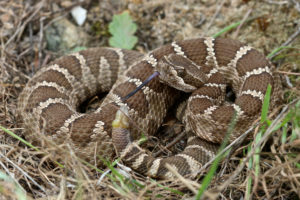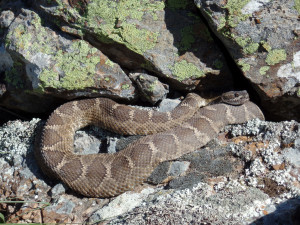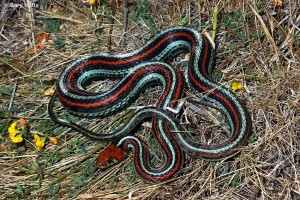Summer is upon us, and the rattlers are out. Or rather, you are. Which makes you much more vulnerable to running into one.
Time to get smart about rattlers if you’re planning a hiking trip anywhere in the Bay Area, or the Western U.S. for that matter. Already this year, experts are attributing warm weather to a big uptick in rattlesnake bites in dogs in Sonoma County.
Rattlesnakes are a key part of the ecosystem by keeping the rodent population in check, but they’re not exactly our best friend. Of California’s six venomous snakes, all of them are species of rattlesnakes.
They’re not aggressive — usually they bite only when they feel provoked or threatened — but accidental encounters and handling account for more than 800 bites each year in the U.S. Only one or two of those bites cause death, but almost all require medical treatment. About 25 percent of the bites are “dry,” meaning no venom was injected.
Certainly, more rattlesnakes die at humans hands than the other way around — lots of them die from car strikes, for instance. But there are some good ways to avoid a tussle with a rattler, and to observe them from a safe distance so that both of you can go your happy ways.
Rattlers love rocks. That’s because they’re warm, full of rodents, and the crevices between rocks can offer shade and protection from their own predators (yes, rattlers are themselves prey to hawks, weasels and king snakes). For the same reason, they also like riverbanks. So, rocks and the edge of rivers is where you have to be especially alert.
Oddly enough, they’re most likely out and about during daytime in the winter months, because they need an extra energy boost from the sun (as reptiles, they are cold blooded). On hot summer days, they seek shade when the sun is blazing, so as not to overheat, and it’s nighttime when they are most active. Heading out from your campfire to visit the WC? That’s when you’re most vulnerable. Paved roadways are one of the top spots where they hang out because the asphalt is still warm, so take a flashlight and stay on the paved surface because rattlers are hard to spot in the gravel along roadside.
Also, you’ll need to watch out pretty everywhere in temperate California, because their habitat is pretty expansive, from sea level to elevations of more than 10,000 feet. Although they dislike disturbed environments, and development has been a major cause of species decline, rattlesnakes can be found near urban areas along lakeside parks and at golf courses. They can also wander into your backyard; you can look into putting up a rattlesnake-proof fence if they’re a problem.
Here are some quick Do’s and Dont’s in rattlesnake country:
- Wear hiking boots. Don’t go barefoot or in sandals.
- Stick to well-used trails and avoid tall grass and underbrush, where they like to hide
- Do not step or put your hands where you cannot see, and avoid wandering around in the dark.
- Check stumps or logs before sitting down, and be careful when climbing rocks or gathering firewood
- Shake out your sleeping bags before use
- Never grab at “sticks” or “branches” while swimming, because rattlesnakes can swim, too. Also get in and out of lakes or rivers at sandy spots.
- Be careful along the edge of buildings and doorsteps, where rattlers like to hang out for protection
- If you do get bitten, wash the area gently with soap and water, immobilize the bite area, remove anything that constricts the swelling such as watches or jewelry, and get to a doctor immediately.
If you do see a rattlesnake out there, appreciate them from afar. They’re actually pretty amazing creatures. Photographer Tony P. Iwane captured a number of Northern Pacific rattlesnakes on his journeys through the Bay Area. Check out more of his images on his Flickr page:
[slideshow]
Alison Hawkes is the online editor of Bay Nature.





